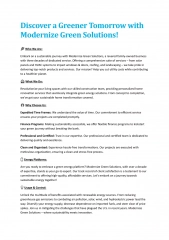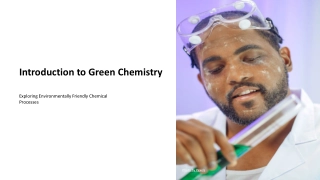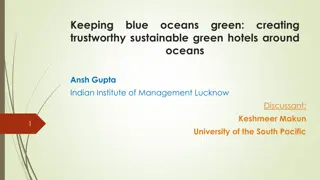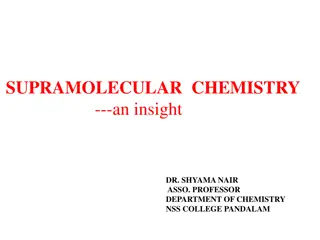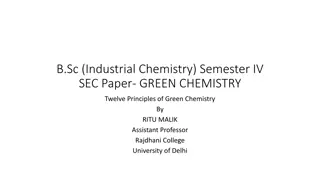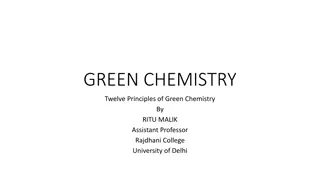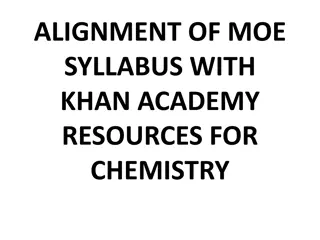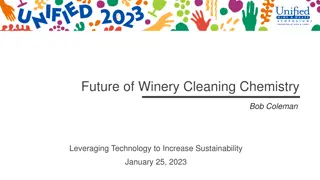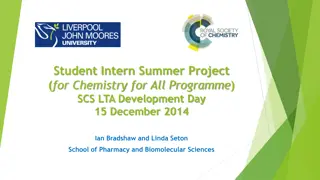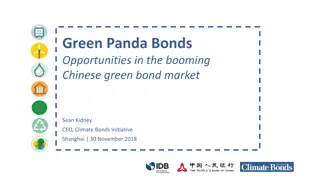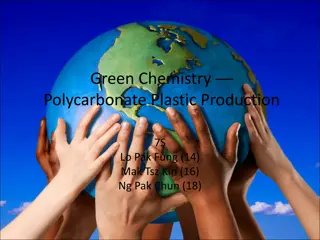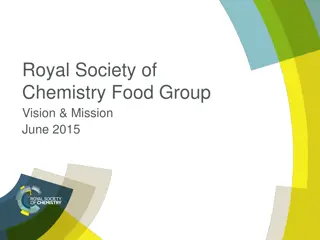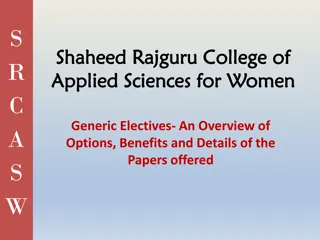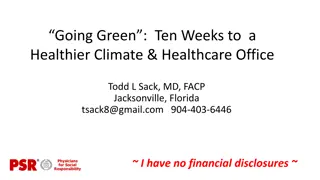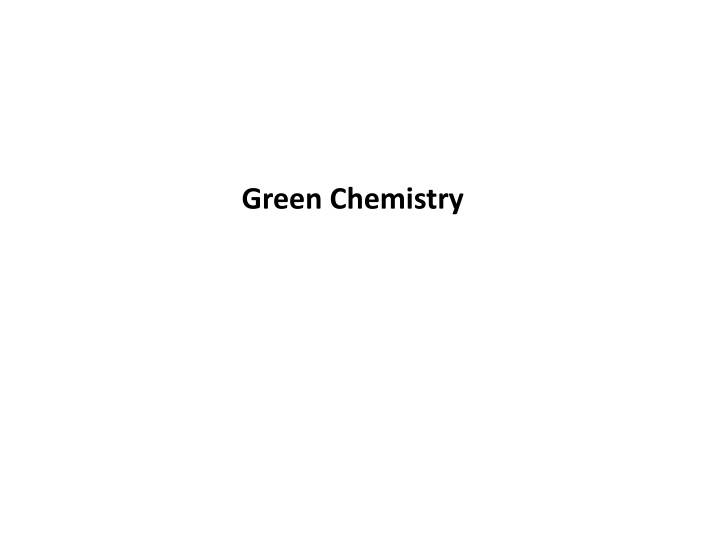
Unveiling Green Chemistry Solutions
Embrace Green Chemistry to solve environmental problems through sustainable practices. Explore why people prefer terms like Natural, Organic, Sustainable for products. Learn about incidents like the Ohio Train Derailment due to hazardous materials like vinyl chloride. Understand the importance of reducing chemical risks and recognizing harmful substances like DDT, benzene, and lead.
Download Presentation

Please find below an Image/Link to download the presentation.
The content on the website is provided AS IS for your information and personal use only. It may not be sold, licensed, or shared on other websites without obtaining consent from the author. If you encounter any issues during the download, it is possible that the publisher has removed the file from their server.
You are allowed to download the files provided on this website for personal or commercial use, subject to the condition that they are used lawfully. All files are the property of their respective owners.
The content on the website is provided AS IS for your information and personal use only. It may not be sold, licensed, or shared on other websites without obtaining consent from the author.
E N D
Presentation Transcript
Green Chemistry Green Chemistry offers a solution to a problem So, what is that problem?
Green Chemistry Here are some words that are used to describe products we buy and use: Chemical, Green, Synthetic, Made, Home-made, Engineered, Chemical-free, Sustainable, Preservative, Recycled, Modified, Pesticide, Natural, Organic Which do people generally like to hear about their products?
Green Chemistry What do people generally like to hear about products? Chemical Natural Synthetic Engineered Modified Made Preservative Pesticide Organic Green Sustainable Home-made Chemical-free Recycled For many chemical and related terminology is negative But why?
Green Chemistry Here s a reason: What s this stuff? PVC pipe PVC = polyvinyl chloride Made from vinyl chloride To have PVC we occasionally have to deal with incidents like .. The 2023 Ohio Train Derailment
Green Chemistry The 2023 Ohio Train Derailment: East Palestine, Ohio 49 cars in derailment pile, which caught fire and burned for days 11 were tank cars, which dumped 100,000 gallons of hazardous materials, including vinyl chloride, benzene residue, and butyl acrylate.
Green Chemistry The 2023 Ohio Train Derailment: To reduce the explosion risk, the vinyl chloride cars were ruptured, drained into a trench, and the material set on fire. This produced HCl and phosgene and soot! All kinds of concerns about soil, water, and air contamination!
Green Chemistry Have you heard of all of these? DDT arsenic mercury PFAS benzene carbon dioxide dioxin ozone lead BPA These are some of the well-recognized chemicals causing environmental concern
Green Chemistry Advances in chemistry have provided us with many things. e.g. Related to Transport, Communication, Living, etc. Let s pick one area Transportation What are chemistry advances that were not available say 50 years ago?
Green Chemistry Advances in chemistry have provided us with many things. These have come at some cost, one manifestation is pollution Aside from gradual impacts on the environment, there have been many notable incidents Some US examples: Cuyahoga river ~1870-1970 (caught fire (13 times!)) Love canal ~1970 (various chemicals) Times beach ~1983 (dioxin contamination)
Green Chemistry Some More Recent Big Incidents Cement creek Colorado 2015 3 million gallons of mine (Gold King mine) waste into river Arsenic, cadmium, lead, mercury, (aluminum, copper) Deepwater Horizon oil spill, April 2011 210 million gallons released http://c1.nrostatic.com/sites/default/files/styles/original_image_with_cropping/public/uploaded/animas-river-epa-criticism.jpg?itok=hn39Qf2-
Green Chemistry Actually - There s some kind of notable chemical incident in the US about every other day! Coalition to Prevent Chemical Disasters: https://preventchemicaldisasters.org/chemical-incident-tracker/overview
Green Chemistry Each big incident leads to a public response and then a government response. As a result, the following policies have been developed: Clear Air Act The Resource Recovery and Conservation Act The Safe Drinking Water Act Superfund in the USA So, there has been a gradual evolution since about 1945 until now that has better regulated our dispensing of chemicals into the environment.
Green Chemistry Chemists may have created problems, but they are also the ones to solve them! For example gasoline powered cars Emissions Problems Solved: Lead SOx NOx CO - alternative anti-knock additives have been employed most sulfur is now removed from gasoline before use catalytic converter - N leaves as N2 catalytic converter - C leaves as CO2 Volatile hydrocarbons - catalytic converter Now just down to the inescapable problems of CO2 production and fossil fuel depletion
Green Chemistry How do we deal with chemical hazards? What are some types of chemical hazards? Explosive, lachrymator, vesicant, pyrophoric, carcinogen, teratogen, sternutator, caustic, corrosive, oxidizer, irritant, sensitizer. Hazards Poison is in everything, and no thing is without poison. The dosage makes it either a poison or a remedy. Paracelsus a renowned alchemist of the 16th century Really? What about air? What about water? Are those poisons?
Green Chemistry Air Quick Q What are the major components air? 78% nitrogen (N2), 21% oxygen (O2), ~1% argon (Ar), ~1% H2O Anyone been scuba diving? Breathing air at increased pressure causes humans to experience nitrogen narcosis - similar effect to alcohol. Oxygen becomes toxic above a certain pressure, when diving deep enough oxygen toxicity is also a problem.
Green Chemistry Water Hyponatremia (low sodium concentration in the blood)
Green Chemistry Anastas and Warner provide the following formula: Risk = f[hazard,exposure] One strategy is that if we can reduce or eliminate exposure we can reduce or eliminate risk From there we can consider ideas of exposure controls
Green Chemistry Which control method is most effective? https://makesafetools.com/osha-hierarchy-of-controls/
Green Chemistry Problems with exposure controls (= end of pipe controls) Uncertainties exist with all of the following: Risks are not known for many (most?) substances Synergistic effects Chronic effects Bioaccumulation and what if the exposure controls fail?
Green Chemistry Green Chemistry aims to address chemical hazard problems here No hazard = no risk (Risk = f[hazard,exposure])
Green Chemistry Exposure Controls Amounts to reducing risks to an acceptable level Acceptable to whom? Green Chemistry minimizes hazards by not using hazardous materials or generating hazardous products in the first place!
Green Chemistry Green chemistry is the design of chemical products and processes that reduce or eliminate the use or generation of hazardous substances. Green chemistry applies across the life cycle of a chemical product, including its design, manufacture, use, and ultimate disposal. Green chemistry is also known as sustainable chemistry. - Environmental Protection Agency (EPA) https://www.epa.gov/greenchemistry/basics-green-chemistry#definition
Green Chemistry Green Chemistry vs Cleaning up Pollution? Cleaning up pollution (also called remediation) involves treating waste streams (end-of-the-pipe treatment) or cleanup of environmental spills and other releases - Removes hazardous materials from the environment Green Chemistry reduces pollution at its source by minimizing or eliminating the hazards of chemical feedstocks, reagents, solvents, and products - in the first place Keeps hazardous materials out of the environment https://www.epa.gov/greenchemistry/basics-green-chemistry#definition
12 Principles of Green Chemistry 1. Prevent Waste 2. Maximize Atom Economy 3. Design Less Hazardous Chemical Syntheses 4. Design Safer Chemicals and Products 5. Use Safer Solvents and Reaction Conditions 6. Increase Energy Efficiency 7. Use Renewable Feedstocks 8. Avoid Chemical Derivatives 9. Use Catalysts, not Stoichiometric Reagents 10.Design Chemicals and Products to Degrade after Use 11.Analyze in Real-time to Prevent Pollution 12.Minimize the Potential for Accidents https://www.epa.gov/greenchemistry/basics-green-chemistry#definition
Green Chemistry Using Green Chemistry has broad benefits If, for example, a company adopts a green chemistry process they will see benefits beyond just reducing environmental impact from their process: Lowered costs Fewer hazardous shipping costs Reduced waste disposal costs Reduced infrastructure costs (more hazards = more expensive equipment to deal with them) Less time used managing safety/hazards etc.
Green Chemistry - Examples 1996 Green Chemistry Challenge Award Winner - Dow Chemical Company Designing an Environmentally Safe Marine Antifoulant We are talking about ships e.g cargo ships What is fouling? Unwanted growth of plants and animals on the ships hull What s the problem? Increased drag through the water Use a chemical agent to kill the fouling organisms
Green Chemistry - Examples 1996 Green Chemistry Challenge Award Winner - Dow Chemical Company Designing an Environmentally Safe Marine Antifoulant TBTO was heavily used. It was incorporated in the paint on the hull. Slowly leached out killing the fouling organisms Long half-life in the environment (~6 months) Bioconcentrates in marine organisms (chronically toxic) Tributyltin oxide (TBTO)
Green Chemistry - Examples 1996 Green Chemistry Challenge Award Winner - Dow Chemical Company Designing an Environmentally Safe Marine Antifoulant Dow developed Sea-Nine 211 Low water solubility No bioaccumulation in the food chain Not persistent (half-life <1 h) Competitive price/performance 4,5-dichloro-2-n-octyl-4-isothiazolin-3-one (DCOI) TBTO banned worldwide by the International Marine Organization, phased out by 2008
Green Chemistry - Examples The Green Chemistry Challenge Awards promote the environmental and economic benefits of developing and using novel green chemistry. Sponsored by the Environmental Protection Agency (EPA) Partners American Chemical Society (ACS) Green Chemistry Institute Industrial Trade Associations Academic Institutions other Government Agencies
Green Chemistry Challenge 2023 Award Winners https://www.epa.gov/greenchemistry/green-chemistry-challenge-winners
Green Chemistry Challenge https://www.epa.gov/greenchemistry/green-chemistry-challenge-winners
Example - Greener Oxidation Procedure U of A Old Procedure: Current Procedure: What makes the newer procedure greener? 1. Reactant/reagent/solvent safety? - for people doing the experiment - to the environment 2. Waste - what is the waste? - how does it need to be disposed of?
Greener Oxidation Procedure U of A Other products: Unreacted Cr(VI) highly toxic, carcinogenic, major environmental hazard Cr(III) - environmental hazard H2SO4 - highly corrosive Ether - volatile, flammable Water Old Procedure: New Procedure: Other products (after NaHSO3 addition): Na+ K+ HSO4- SO42- Cl- Ethyl acetate - flammable Water
Greener Oxidation Procedure U of A Old Procedure: 1. 2. 3. Prevent Waste Maximize Atom Economy Design Less Hazardous Chemical Syntheses Design Safer Chemicals and Products Use Safer Solvents and Reaction Conditions Increase Energy Efficiency Use Renewable Feedstocks Avoid Chemical Derivatives Use Catalysts, not Stoichiometric Reagents 10. Design Chemicals and Products to Degrade after Use 11. Analyze in Real-time to Prevent Pollution 12. Minimize the Potential for Accidents 4. 5. Current Procedure: 6. 7. 8. 9. Which of the 12 principles of green chemistry are incorporated in this example?
Greener Oxidation Procedure U of A Old Procedure: Current Procedure: Is the new procedure perfectly green? If not, what types of changes would be needed to make it even greener?
Green Chemistry Importantly, in practice very few processes are entirely green Realistically, while that is the goal, a more typical sub-goal is to make processes greener Metrics have been developed to assess the greenness of processes e.g. Atom economy, Effective mass efficiency, E factor, EcoScale
Greener Oxidation Procedure U of A Old procedure: Current procedure: In this oxidation lab experiment example ideally, there would be no solvent (or water as solvent?), oxygen from the air would be used (maybe with a catalyst) as the oxidizing agent, etc.
Green Chemistry This Page (EPA) contains link to many resources for further information about Green Chemistry https://www.epa.gov/greenchemistry/green-chemistry-resources#education

